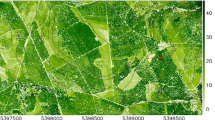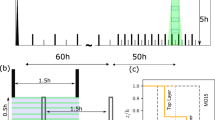Abstract
Many forest management methods alterstand density uniformly. The effectsof such a change on the wind andturbulence regimes in the forest arecritical to a number of processes governingthe stability of the stand and itsmicroclimate. We measured wind speed andturbulence statistics with a Dantec tri-axialhot-film probe in model forests of variousdensities (31–333 trees m-2), created byremoving whole trees in a regular pattern in awind tunnel, and compared them with similarmeasurements made with propeller anemometers insimilarly thinned plots (156–625 trees ha-1)within a Sitka spruce stand in Scotland. The results agree well, in general, with measurements made inother such studies with diverse canopy types.The systematic variations with density and verticalleaf-area distribution (which differed betweenwind-tunnel and field trees) in our work can explainmuch of the variability shown in scaled profiles ofbasic turbulence statistics reported in theliterature. The wind tunnel and field results are shown to be in good agreement overalldespite the difference in vertical leaf-areadistribution. Within-canopy and isolated-treedrag coefficients in the wind tunnel showthat tree-scale shelter effects increase astree density increases. The measurements indicatethat turbulence in the canopy is dominated bylarge-scale structures with dimensions of the sameorder as the height of the canopy as found inother studies but suggest that inter-tree spacing also modulates the size of these structures. These structures are associated with the sweeps that dominatemomentum exchange in the canopy and it is thisfact that allows the tri-axial probe to operate sowell despite the relatively narrow range of anglesin which the wind vector is correctly measured. Theratio of streamwise periodicity of these structuresto vorticity thickness varies systematically withtree density in the range 2.7–5.1, which spans theexpected range of 3.5–5 found in a laboratorymixing-layer, suggesting that tree spacing imposes another relevant length scale. This test andothers show that the results are in agreement withthe idea that canopy turbulence resembles that of a mixing layer even though they disagree with, and challenge the linear relationship between, streamwise periodicity andshear length scale presented recently in theliterature. The measurements are also in goodoverall agreement with simple drag models presented recently by other researchers.
Similar content being viewed by others
References
Brunet, Y., Finnigan, J. J., and Raupach, M. R.: 1994, ‘A Wind Tunnel Study of Air Flow in Waving Wheat: Single-Point Velocity Statistics’, Boundary-Layer Meteorol. 70, 95–132.
Bruun, H. H.: 1995, Hot-Wire Anemometry, Principles and Signal Analysis, Oxford University Press, Oxford, 507 pp.
Chen, J.M., Black, T. A., Novak, M. D., and Adams, R. S.: 1995, ‘AWind Tunnel Study of Turbulent Air Flow in Forest Clearcuts’, in M. P. Coutts and J. Grace (eds.), Wind and Trees, Chapter 4, Cambridge University Press, London, pp. 71–87.
Counihan, J.: 1969, ‘An Improved Method of Simulating an Atmospheric Boundary Layer in a Wind Tunnel’, Atmos. Environ. 3, 197–214.
Finnigan, J. J.: 1979a, ‘Turbulence in Waving Wheat. I. Mean Statistics and Honami’, Boundary-Layer Meteorol. 16, 181–211.
Finnigan, J. J.: 1979b, ‘Turbulence in Waving Wheat. II. Structure of Momentum Transfer’, Boundary-Layer Meteorol. 16, 213–236.
Green, S. R., Grace, J., and Hutchings, N. J.: 1995, ‘Observations of Turbulent Air Flow in Three Stands of Widely Spaced Sitka Spruce’, Agric. For. Metorol. 74, 205–225.
Jørgensen, F. E.: 1971, ‘Directional Sensitivity of Wire and Fiber-Film Probes, An Experimental Study’, DISA Information 11, 31–37.
Liu, J., Chen, J. M., Black, T. A., and Novak, M. D.: 1996, ‘E — ∈ Modelling of Turbulent Air Flow Downwind of a Model Forest Edge’, Boundary-Layer Meteorol. 77, 21–44.
Massman, W. J.: 1997, ‘An Analytical One-Dimensional Model of Momentum Transfer by Vegetation of Arbitrary Structure’, Boundary-Layer Meteorol. 83, 407–421.
Novak, M. D., Orchansky, A. L., Adams, R. S., Chen, W. J., and Ketler, R.: 1997, ‘Wind and Temperature Regimes in the B-5 Clearing at the Sicamous Creek Silvicultural Systems Research Area: Preliminary Results from 1995’, in C. Hollstedt and A. Vyse (eds.), Sicamous Creek Silvicultural Systems Project: Workshop Proceedings, April 24–25, 1996, Kamloops, British Columbia, Canada, B.C. Ministry of Forests, Victoria, British Columbia, pp. 45–56.
Nyland, R. D.: 1996, Silviculture Concepts and Applications, McGraw-Hill, New York, 633 pp.
Orchansky, A. L., Novak, M. D., Ketler, R., and Adams, R. S.: 1997, ‘Effects of Forest Clearing Characteristics on Wind Regimes: Wind Tunnel and Field Comparison’, in 12th Symposium on Boundary Layers and Turbulence, July 28–August 1, 1997, Vancouver, B.C., American Meteorological Society, Boston, MA, pp. 548–549.
Raupach, M. R.: 1981, ‘Conditional Statistics of Reynolds Stress in Rough-Wall and Smooth-Wall Turbulent Boundary Layers’, J. Fluid Mech. 136, 111–137.
Raupach, M. R.: 1992, ‘Drag and Drag Partition on Rough Surfaces’, Boundary-Layer Meteorol. 60, 375–395.
Raupach, M. R.: 1994, ‘Simplified Expressions for Vegetation Roughness Length and Zero-Plane Displacement as Functions of Canopy Height and Area Index’, Boundary-Layer Meteorol. 71, 211–216.
Raupach, M. R., Coppin, P. A., and Legg, B. J.: 1986, ‘Experiments on Scalar Dispersion within a Model Plant Canopy, Part I: The Turbulent Structure’, Boundary-Layer Meteorol. 35, 21–52.
Raupach, M. R., Finnigan, J. J., and Brunet, Y.: 1996, ‘Coherent Eddies and Turbulence in Vegetation Canopies: The Mixing-Layer Analogy’, Boundary-Layer Meteorol. 78, 351–382.
Raupach, M. R., Thom, A. S., and Edwards, I.: 1980, ‘AWind-Tunnel Study of Turbulent Flow Close to Regularly Arrayed Rough Surfaces’, Boundary-Layer Meteorol. 18, 373–397.
Shaw, R. H., Brunet, Y., Finnigan, J. J., and Raupach, M. R.: 1995, ‘A Wind Tunnel Study of Air Flow in Waving Wheat: Two-Point Velocity Statistics’, Boundary-Layer Meteorol. 76, 349–376.
Shaw, R. H., den Hartog, G., and Neumann, H. H.: 1988, ‘Influence of Foliar Density and Thermal Stability on Profiles of Reynolds Stress and Turbulence Intensity in a Deciduous Forest’, Boundary-Layer Meteorol. 45, 391–409.
Stacey, G. R., Belcher, R. E., Wood, C. J., and Gardiner, B. A.: 1994, ‘Wind and Wind Forces in a Model Spruce Forest’, Boundary-Layer Meteorol. 69, 311–334.
Tanner, C. B. and Thurtell, G. W.: 1969, ‘Anemoclinometer Measurements of Reynolds Stress and Heat Transport in the Atmospheric Surface Layer’, Research and Development Technical Report, ECOM 66-G22-F, Final Report.
Taylor, P. A.: 1988, ‘Turbulent Wakes in the Atmospheric Boundary Layer’, in W. L. Steffen and O. T. Denmead (eds.), Flow and Transport in the Natural Environment: Advances and Applications, Springer-Verlag, Berlin, pp. 270–292.
Thom, A. S.: 1971, ‘Momentum Absorption by Vegetation’, Quart. J. Roy. Meteorol. Soc. 97, 414–428.
Weetman, G. and Vyse, A.: 1990, ‘Natural Regeneration’ in D. P. Lavender, R. Parish, C.M. Johnson, G. Montgomery, A. Vyse, R. A. Willis, and D. Winston (eds.), Regenerating British Columbia's Forests, University of British Columbia Press, Vancouver, British Columbia, pp. 118–130.
Weiss, A. and Allen, L. H. Jr.: 1976, ‘The Flux-Angle Distribution of Momentum as Determined from Propellor Anemometer Measurements’, Quart. J. Roy. Meteorol. Soc. 102, 775–779.
Author information
Authors and Affiliations
Rights and permissions
About this article
Cite this article
Novak, M.D., Warland, J.S., Orchansky, A.L. et al. Wind Tunnel And Field Measurements Of Turbulent Flow In Forests. Part I: Uniformly Thinned Stands. Boundary-Layer Meteorology 95, 457–495 (2000). https://doi.org/10.1023/A:1002693625637
Issue Date:
DOI: https://doi.org/10.1023/A:1002693625637




